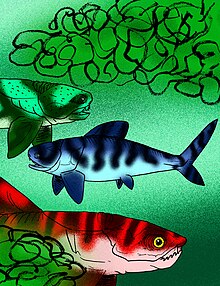| Selenosteidae Temporal range: Late Devonian,
| |
|---|---|

| |
| Driscollichthys, Amazichthys, Draconichthys | |
| Scientific classification | |
| Domain: | Eukaryota |
| Kingdom: | Animalia |
| Phylum: | Chordata |
| Class: | †Placodermi |
| Order: | †Arthrodira |
| Suborder: | †Brachythoraci |
| Clade: | †Eubrachythoraci |
| Clade: | †Pachyosteomorphi |
| Clade: | †Aspinothoracidi |
| Family: | †Selenosteidae Dean, 1901 |
| Type species | |
| Selenosteus brevis (Claypole), 1869
| |
| Genera | |
| Synonyms | |

Selenosteidae is an extinct family of small to large-sized arthrodire placoderms from the Late Devonian. With the exception of the Chinese Phymosteus, selenosteids lived in shallow seas in what is now Eastern North America (the Cleveland Shale), Eastern Europe (Holy Cross Mountains, Poland, and the Kellwasserkalk fauna of Bad Wildungen), and Northeastern Africa (the Anti-Atlas Mountains, Morocco).
Selenosteids have, in cross section, a rounded body, a blunt snout, and tremendous orbits. The lower jaws were slender, the inferognathals usually either being finely serrated, or adapted for crushing,[1] though, in Draconichthys, the inferognathals had long prongs for seizing prey.[2] The rostrum is very small.
- ^ Denison, Robert (1978). Handbook of Paleoichthyology, Volume 2, Placodermi. New York: Gustav Fischer Verlage. p. 94. ISBN 9780895740274.
- ^ RÜCKLIN, MARTIN (January 14, 2011). "First selenosteid placoderms from the eastern Anti-Atlas of Morocco; osteology, phylogeny and palaeogeographical implications". Palaeontology. 56 (1): 25–62. doi:10.1111/j.1475-4983.2010.01026.x.